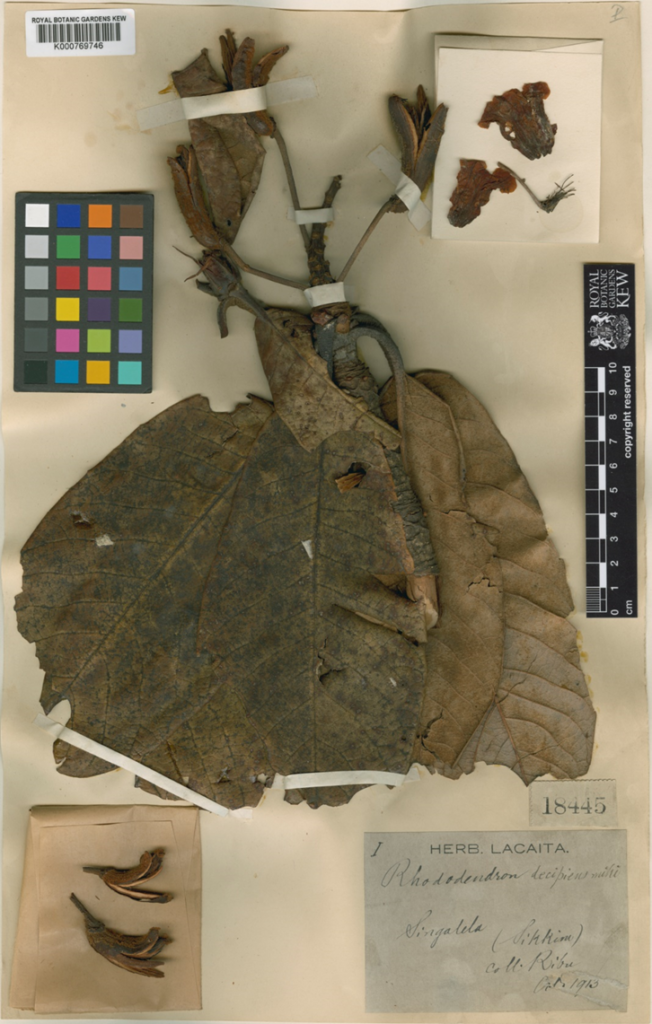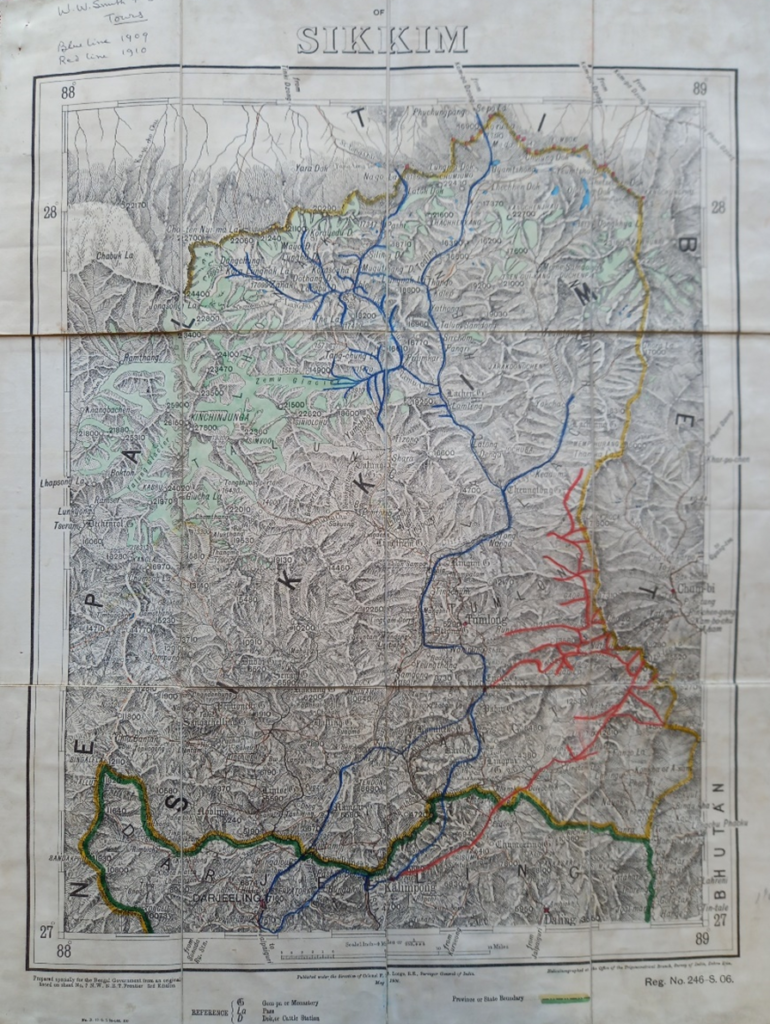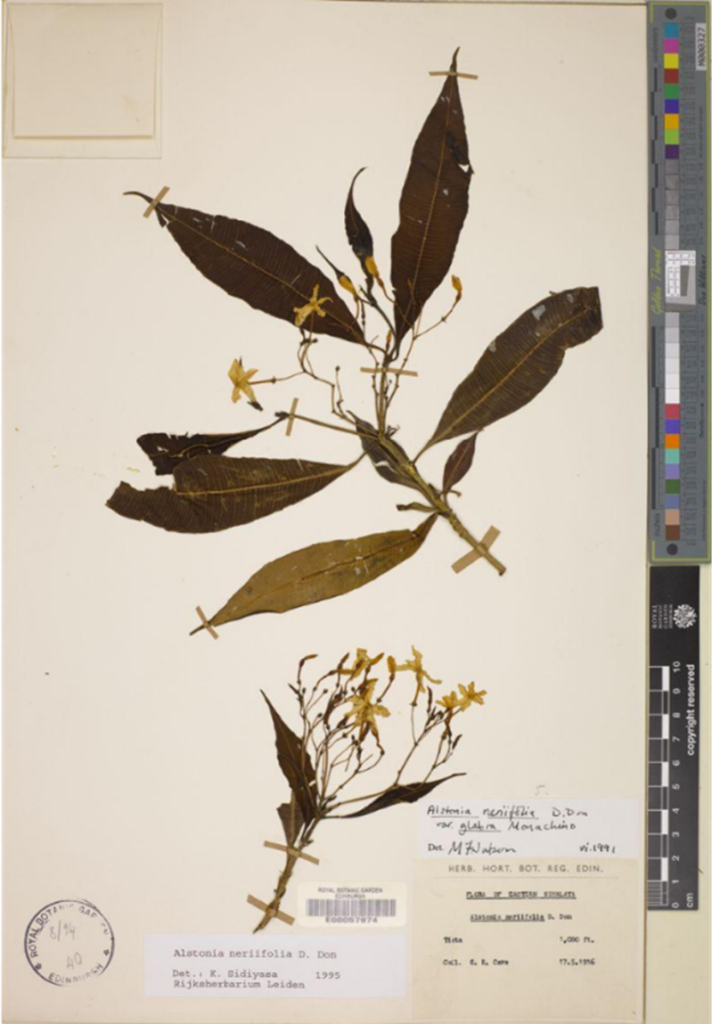George Herbert Cave of Windsor, southeast England (1872-1965), was a botanist and plant collector who rapidly rose to prominence in the Victorian era. He collected plants in Sikkim in northeast India, eventually becoming the curator of the Lloyd Botanic Garden in neighbouring Darjeeling. Cave began his career as a gardener at Kew where he gained a tertiary degree in botany. Pursuing a passion for the native Himalayan flora, the Darjeeling curator position enticed Cave to initiate numerous plant collecting tours into Sikkim, from his position at the Lloyd Botanic Gardens in Darjeeling, West Bengal. Extensive documentation of Cave’s expeditions into Sikkim are held in the Royal Botanic Garden Edinburgh (RBGE) Archive.

Pencil sketch of G.H. Cave drawn by Dean Blake from a photograph in the RBGE Archives (GB235/CAV/1/1/4/25/1).
Together with fellow botanist and future RBGE Regius Keeper William Wright Smith, George Herbert Cave collected 4576 species in Sikkim, Bhutan and Darjeeling; twenty-seven of these specimen collections date between 1909-1924 and are preserved in the RBGE Herbarium.
George Herbert Cave received recognition from prominent figures of the period, both for military service and duty and for preserving and attaining a scientific record of the flora of Sikkim. George Herbert Cave was honoured with a traditional Tibetan teacup from the Dalai Lama and received an MBE upon returning to Britain from his spiritual homeland of the Indian Subcontinent.
Voyage to Calcutta
George Herbert Cave gained appointment in 1896 as an assistant in the Botanic Gardens in Calcutta, travelling from Gravesend aboard the S.S. Goorkha to fulfil his new position. In Calcutta, Cave met Catherine Bayliss. They married in 1898 in Howrah, West Bengal, and produced three sons, George in 1899, Jonathan in 1903 and Gordon in 1905.
Photograph of Cave and Catherine Bayliss from Rowena Cave’s published transcription of George Cave’s diary, Sikkim, July 1906; RBGE Archive, GB235/CAV/2/1/2.
In 1900 Cave was assigned as governor of a Cinchona officinalis plantation in the Darjeeling foothills of Bengal, governing the Mungpoo division. [Cinchona was grown to provide quinine, used as a treatment for malaria.] For the duration of Cave’s governance of the C. officinalis plantation, rapid expansion of the plantation industry subsequently altered ecological and demographic characteristics of the Bengal region. Following the introduction of migrant labour camps, malaria cases were rapidly increasing, the poor sanitary conditions of the labour camps stated as being a predominant cause according to the medical history journal ‘The logic of location: Malaria research in colonial India, Darjeeling and Duars, 1900–30‘. Modernisation of India and the introduction of plantations, railways, commercial agriculture and rice paddy fields fundamentally altered the landscape, making it less environmentally beneficial, but with higher economic value. Modernised landscape features are in stark contrast to pre-colonial India, in reference to ‘In the City, Out of Place’ by Sharan. A, 2006. This change came following Cave’s arrival, and his career defining opportunity to govern an economically prominent section of quinine production.

Photograph of Darjeeling plantation workers sowing cinchona for quinine production, c.1905 Munsong, a nearby plantation to G.H. Cave’s Mungpoo division in Darjeeling, courtesy of the Wellcome Collection online database 2021. Credit: Sowing cinchona seeds in a nursery bed, Munsong plantation; date:1905-1920; Reference:564489i
At the time of Cave’s governance, approximately 450 acres and 1 million C. officinalis and C. officinalis varieties were cultivated. Following his training in botany at Kew, a significant rise in status marked an opportunity for Cave to exercise his knowledge of botany and establish prominence as the region’s leading plantation governor. Yet, four years later in 1904, Cave acquired a new position, joining the Agricultural-Horticultural Society of India, based at Lloyd Botanic Gardens in Darjeeling, West Bengal as garden curator.
George Herbert Cave remained in Lloyd Botanic Gardens for the next 24 years (1904-1928) enabling his plant collection expeditions, travelling north from Darjeeling into the regions of Tibet, Sikkim, and Nepal.
1906 Sikkim Tour
George Herbert Cave conducted tours with colleagues and Lepcha locals (indigenous peoples of Sikkim) to identify and collect specimens of the Eastern Himalayas.
The 1906 tour began with finding local labourers, many of whom were Lepcha. Three Lepcha collectors and nine of Cave’s own company set off after mapping out the route and attaining pack animals for transportation as detailed in Rowena Cave’s 2008 transcription of her grandfather’s diary, held in the RBGE Archives. The route began in Darjeeling and ended in Sikkim’s capital Gangtok. George Herbert Cave navigated the perilous mountains of Sikkim’s outlands, collecting many varieties of flowering plants.
The 60 metre high crossing in North Sikkim was especially hazardous, the bridge was fragile and slippery from the splashing of the waterfall directly parallel, the walkway was twisted and disformed, swaying briskly from side to side, each step required a great deal of attention for the pack heavy travellers.
Photograph from 1904, showing a bridge made of cane bamboo in Sikkim which Cave crossed on his 1906 Sikkim tour; from Rowena Cave’s 2008 published transcription of George Cave’s Diary: Sikkim, July 1906, RBGE Archive, GB235/CAV/2/1/2.
Whilst Cave benefitted from the knowledge of the Lepcha on safe routes, paths and the local flora, he in turn provided botanical training for his Lepcha guides. Following guidance from Cave, a Lepcha follower named Ribu made his own specimen collections.

Rhododendron hodgsonii Hook.f. specimen collection from one of George Herbert Cave’s closest followers Ribu, dated 1913 Kew Botanic Garden herbarium, (1913), GBIF. https://www.gbif.org/occurrence/912586902.

On the left: The Head Lama of Sikkim, photograph from 1880. On the right: Traditional lama of Sikkim Cave encountered on 1906 tour of Sikkim, from Rowena Cave’s 2008 published transcription of George Cave’s Diary: Sikkim, July 1906, RBGE Archive, GB235/CAV/2/1/2.
On many occasions during the 1906 tour, Cave was in contact with spiritual heads of Sikkim, describing encounters with many Sikkim lamas as “polite but not at all cordial”.
The 1906 tour ended in Gangtok, Cave having successfully gathered a variety of specimens and grown more accustomed with the flora and local people of Sikkim. The knowledge and experience he gained on this trip inspired him to undertake further expeditions in the future.
1909-1910 Sikkim Tour
Cave’s 1909-1910 tours were conducted with companion traveller William Wright Smith of Calcutta Botanic Garden and produced an abundance of plant material for admission to herbarium collections both at the Lloyd Botanic Garden and the Royal Botanic Garden Edinburgh.

Map of the route Cave and Smith conducted in 1909 (blue line) and 1910 (red Line), RBGE Archive, GB235/CAV/2/3/2, (published by the Surveyor General of India, May 1906).
Many collections and identifications attributed to Cave and Smith’s tours received the epithet cavei or caveana such as Magnolia caveana, Primula caveana and Corydalis cavei. The publication ‘Notes from the Royal Botanic Garden, Edinburgh‘, Volume 42, 1984 provides the first identification of the species Corydalis cavei by RBGE staff member Dr David Long.

Alstonia neriifolia, preserved specimen, 1909 G.H.Cave collection from tour in Sikkim, RGBE, Herbarium, 1909.
Sikkim’s climate ranges from sub-tropical to high alpine (300m-8,000m). The Alstonia neriifolia specimen was collected by Cave at a relatively low altitude of 1000m, growing in the sub-tropical areas of Sikkim. The 1906 route allowed Cave to collect and observe species of low altitude sub-tropic climate and high-altitude alpines and orchids. The diversity of flora is described in his diary of alpine collections and mentioned in his ‘Notes on Sikkim Orchids‘ (RBGE Archive, Box 1 of 3 GB235 CAV/6 Folder: 1.Lists of Plants, 2.Notes on Orchids of Sikkim) which detail the characteristics of orchids he observed on the 1906 Sikkim tour.
Pioneer – Service To Bengal
George Herbert Cave had ambitions to create a centre of education in Bengal for locals to achieve horticultural qualifications. George Herbert Cave’s Essay on Horticultural Training in Bengal describes adapting practices from Britain’s botanical centres, including the Royal Botanic Garden Edinburgh and Kew, to improve the theoretical and practical knowledge developed in a Bengal horticultural education program. A monthly report of practical duties required for garden maintenance and detailing a basic proposal for a horticultural training program in Bengal were included in the essay. This provides a basis for what was to become the future of Bengal’s horticultural legacy.

George Herbert Cave volunteered for twenty-five years in the North Bengal Mounted Rifles, a volunteer division of horse mounted riflemen, primarily consisting of British volunteer tea planters, with three active divisions and one reserve; no published information could be found on the activity of this unit. However, the Dalai Lama presented Cave with a Traditional Tibetan Teacup, honouring his dedicated service to the unit.

George Herbert Cave – Return
George Herbert Cave returned to Britain in 1925 to receive an MBE award for work in the Indian subcontinent. Forty years later Cave passed away in 1965 at the age of 93, leaving behind a wealth of specimens, several of which remain in the RBGE herbarium today. Among Cave’s many contributions to horticulture and botany are the mapping and collecting of many of Bengal’s plant species, and an ambitious horticultural education programme in Bengal. His ability to create a dialogue and communicate in local Tibetan and Bhutanese dialects, accompanied his pursuit of his Indian flora collection. The contribution of the local Lepcha community was vital to the success of his expeditions.

“In honour of Mr. George Cave, curator of the Lloyd Botanic Garden at Darjeeling, an indefatigable traveller and collector over the whole of Sikkim and one to whom the discovery of many new plants is due.”
Sir William Wright Smith
Cave’s collection of correspondence between Calcutta and British botanic gardens provides a rich source of material for the interdisciplinary study of colonial botany.
by Dean Blake
RBGE’s George Cave collection has recently been re-catalogued by archives student George Simpson and can be found by clicking here.



Robert W N Cubey
DoB 1870 in IPNI
Leonie Paterson
thanks for this – Cave’s granddaughter gives his date of birth as 1872 and this is backed up by birth records on Ancestry – I note that Desmond’s bibliography of British Botanists gives ‘c.1870’ as Cave’s birth year, and I wonder if this has been used as a definite date by IPNI as there was no other info to go by?
Leonie